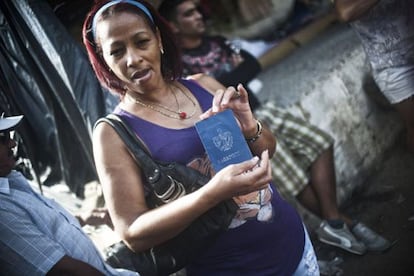Cuban refugees stranded in Costa Rica begin their journey to US
First group of 180 migrants fly to El Salvador to embark on a long trek to the north

With still 10 hours before they were scheduled to leave, Michel Águila and Arnobis Téllez had their migrant backpacks already prepared by midday Tuesday.
The only things they were taking for their long journey to the United States were some clothes, what little money they had, and a cellphone.
We are not guaranteeing they will reach the US but we have guaranteed they will be able to travel through the region”
Costa Rican migration director Kathya Rodríguez
They were hoping to reach the United States by Saturday, but first they had to fly to El Salvador from Costa Rica, where they had been stranded for two months following a diplomatic showdown with neighboring Nicaragua. Once they reach El Salvador, they will have to travel by land across Central America and Mexico.
Michel and Arnobis are two of the first 180 Cuban refugees who were scheduled to fly to El Salvador as part of a coordinated effort with the Costa Rican and other Central American governments.
There are some 8,000 Cuban refugees waiting in Costa Rica to travel to the United States.
In November, the Nicaraguan government closed its borders and prohibited the Cubans from crossing over after Managua accused the government of San Jose of violating international laws by allowing the refugees to travel without transit documents. Hundreds were deported after they reached Nicaragua.
Managua also charged that Costa Rica was dumping people on its side of the border.
The Cubans had arrived by plane in Ecuador, which had lifted travel visas for those from that country, and crossed over into Colombia and Panama before they found themselves stranded and living in makeshift camps on the Costa Rican border.
“Finally, we are going today,” Michel said, after shaving and bathing at a refugee camp set up about 20 kilometers from the Nicaraguan border crossing. “This has been hard but it’s another small step to be taken before we reach the United States.”
The refugees hope to obtain US residency under the Cuban Adjustment Act.
The first group will be taken by bus to Liberia, Costa Rica, where they will board a plane destined for El Salvador.
While many are excited, the refugees have mixed feelings about their journey because they are unclear how they will cross Mexico once they arrive by bus in the southern city of Tapachula.
It is going to be dangerous but we knew this during our original plans” Cuban refugee Arnobis Téllez
“We are not guaranteeing that they will reach the United States but we have guaranteed that they will be able to travel through the region,” said Costa Rican migration director Kathya Rodríguez.
“It is going to be dangerous but we knew this during our original plans,” said Arnobis, who was part of the first group of Cubans that crossed over from Panama.
At the Nocturno de La Cruz school, people celebrated. “Everything is fine, we are a lot calmer,” said Luis Felipe as he was getting a haircut from a fellow refugee. The young man wants to be well-groomed before he embarks on his journey.
His barber, Reinier Montes de Oca, admitted to being jealous because he won’t be leaving soon.
“I am staying for now, but I hope to go soon – maybe around the 20th. But things haven’t been all that bad here in Costa Rica,” he said.
English version by Martin Delfín.
Tu suscripción se está usando en otro dispositivo
¿Quieres añadir otro usuario a tu suscripción?
Si continúas leyendo en este dispositivo, no se podrá leer en el otro.
FlechaTu suscripción se está usando en otro dispositivo y solo puedes acceder a EL PAÍS desde un dispositivo a la vez.
Si quieres compartir tu cuenta, cambia tu suscripción a la modalidad Premium, así podrás añadir otro usuario. Cada uno accederá con su propia cuenta de email, lo que os permitirá personalizar vuestra experiencia en EL PAÍS.
¿Tienes una suscripción de empresa? Accede aquí para contratar más cuentas.
En el caso de no saber quién está usando tu cuenta, te recomendamos cambiar tu contraseña aquí.
Si decides continuar compartiendo tu cuenta, este mensaje se mostrará en tu dispositivo y en el de la otra persona que está usando tu cuenta de forma indefinida, afectando a tu experiencia de lectura. Puedes consultar aquí los términos y condiciones de la suscripción digital.
Últimas noticias
The complicated life of Francesca Albanese: A rising figure in Italy but barred from every bank by Trump’s sanctions
How Japan is trying to avert ‘digital defeat’
Reinhard Genzel, Nobel laureate in physics: ‘One-minute videos will never give you the truth’
Pinochet’s victims grapple with José Antonio Kast’s rise in Chile
Most viewed
- Pablo Escobar’s hippos: A serious environmental problem, 40 years on
- Why we lost the habit of sleeping in two segments and how that changed our sense of time
- Trump’s obsession with putting his name on everything is unprecedented in the United States
- The Florida Keys tourist paradise is besieged by immigration agents: ‘We’ve never seen anything like this’
- Charles Dubouloz, mountaineering star, retires at 36 with a farewell tour inspired by Walter Bonatti








































